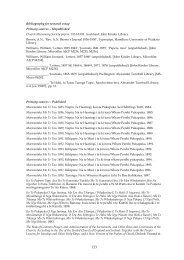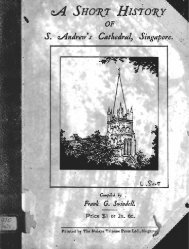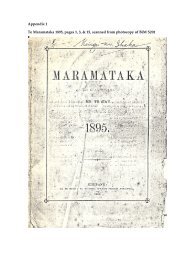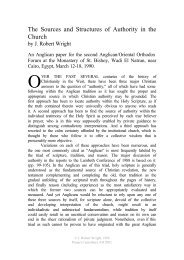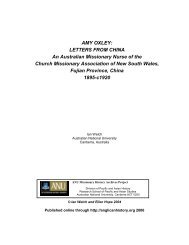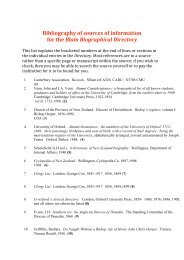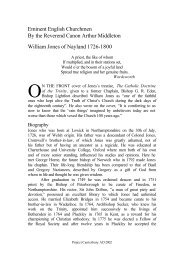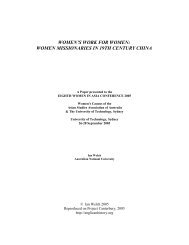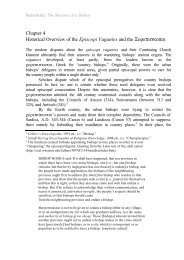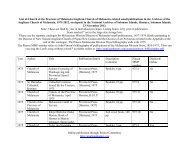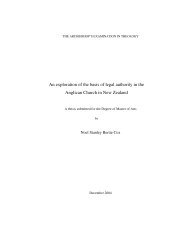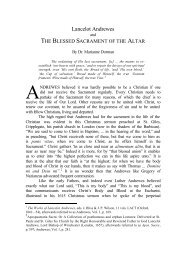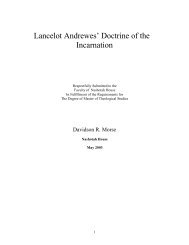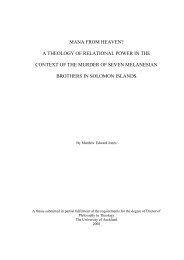The Influence of John Mason Neale and the - Project Canterbury
The Influence of John Mason Neale and the - Project Canterbury
The Influence of John Mason Neale and the - Project Canterbury
You also want an ePaper? Increase the reach of your titles
YUMPU automatically turns print PDFs into web optimized ePapers that Google loves.
<strong>The</strong> <strong>Influence</strong> <strong>of</strong> J.M. <strong>Neale</strong> <strong>and</strong> <strong>the</strong> <strong>The</strong>ology <strong>of</strong> Symbolism, by S.D. de Hart<br />
that unless <strong>Canterbury</strong> claims to be <strong>the</strong> mo<strong>the</strong>r <strong>and</strong> mistress <strong>of</strong> all Churches, she must be<br />
content under <strong>the</strong> pain <strong>of</strong> schism, whenever that tribunal shall speak, to obey it.” 32<br />
<strong>Neale</strong>’s apologetic argued that ancient practice, universal approval, <strong>and</strong> rightful<br />
heritage from <strong>the</strong> primitive church is necessary for appeal in any controversy. This was<br />
an argument that sounded strangely familiar to those who identified with <strong>the</strong> Reformed<br />
character <strong>of</strong> <strong>the</strong> Church <strong>of</strong> Engl<strong>and</strong>. After all, by definition something reformed must<br />
have had a prior existence, <strong>and</strong> <strong>the</strong> purpose <strong>of</strong> reformation is to take that which is original<br />
<strong>and</strong> restore it to its most pure state. Whenever <strong>the</strong> Church begins to view itself as being<br />
without blemish <strong>and</strong> without any need to reform itself by a greater st<strong>and</strong>ard than <strong>the</strong> one<br />
currently in fashion, history has shown that truth will rise up against all that is contrary to<br />
<strong>the</strong> will <strong>of</strong> God for <strong>the</strong> spiritual well-being <strong>of</strong> <strong>the</strong> Body <strong>of</strong> Christ. <strong>The</strong> permanent value <strong>of</strong><br />
<strong>the</strong> Reformation was not a new point <strong>of</strong> origin for <strong>the</strong> church, it was a purifying<br />
movement seeking to rediscover <strong>the</strong> lost heritage <strong>of</strong> <strong>the</strong> primitive church. <strong>The</strong> nineteenthcentury<br />
Ritualist clergy would find some manner <strong>of</strong> justification for <strong>the</strong>ir reforms as <strong>the</strong>y<br />
followed in <strong>the</strong> footsteps <strong>of</strong> <strong>the</strong> sixteenth-century Reformers. Evangelicals would hardly<br />
make such an association between Cranmer <strong>and</strong> <strong>Neale</strong>, but <strong>the</strong> principle motivating both<br />
<strong>of</strong> <strong>the</strong>se men was clearly a felt need for ecclesiastical reformation; looking to <strong>the</strong> past for<br />
<strong>the</strong> path ahead. For <strong>the</strong> Church <strong>of</strong> Engl<strong>and</strong> to maintain any justification for its existence<br />
apart from Rome, it must remain faithful to <strong>the</strong> principle <strong>of</strong> reform. Every church that is a<br />
product <strong>of</strong> <strong>the</strong> Reformation ideals must remember <strong>the</strong> motto ‘semper reformata’, to ever<br />
be reforming. Reformation begins by recognizing <strong>the</strong> Church’s primitive foundation <strong>and</strong><br />
st<strong>and</strong>ing anew upon it against all opposition.<br />
Ritualists assured <strong>the</strong>mselves, though few o<strong>the</strong>rs, <strong>of</strong> <strong>the</strong>ir continuity with <strong>the</strong><br />
primitive Church <strong>and</strong> acted accordingly. Ritualism would first be tested on Prayer Book<br />
meaning <strong>and</strong> practice. <strong>The</strong> Ritualists were persuaded that <strong>the</strong>y had <strong>the</strong> proper<br />
underst<strong>and</strong>ing <strong>of</strong> Anglican liturgical <strong>and</strong> ceremonial tradition, <strong>and</strong> <strong>the</strong>y trusted in <strong>the</strong> law<br />
to vindicate <strong>the</strong>ir position.<br />
Those who had revived <strong>the</strong> ornaments <strong>of</strong> <strong>the</strong> church, <strong>and</strong> some years later, <strong>the</strong><br />
ornaments <strong>of</strong> <strong>the</strong> minister, argued for <strong>the</strong>ir use on <strong>the</strong> authority <strong>of</strong> <strong>the</strong> Prayer Book<br />
Ornaments Rubric, which reads:<br />
And here it is to be noted that <strong>the</strong> Minister at <strong>the</strong> time <strong>of</strong> <strong>the</strong> Communion <strong>and</strong><br />
at all o<strong>the</strong>r times in his ministration shall use such ornaments in <strong>the</strong> church as<br />
were in use <strong>and</strong> retained by authority <strong>of</strong> Parliament in <strong>the</strong> second year <strong>of</strong> <strong>the</strong><br />
reign <strong>of</strong> King Edward VI.<br />
<strong>Neale</strong> argued that his interpretation <strong>of</strong> an historic underst<strong>and</strong>ing <strong>of</strong> <strong>the</strong> Ornaments<br />
Rubric upheld <strong>the</strong> principle <strong>of</strong> continuity in <strong>the</strong> Church <strong>of</strong> Engl<strong>and</strong>, in its liturgy <strong>and</strong><br />
practice, with <strong>the</strong> primitive Church. For <strong>Neale</strong>, such an argument would demonstrate that<br />
<strong>the</strong> purpose <strong>of</strong> <strong>the</strong> Rubric was to restore <strong>and</strong> maintain <strong>the</strong> dignity <strong>of</strong> worship that had<br />
been practiced always in <strong>the</strong> Church <strong>of</strong> Christ. <strong>The</strong>refore, <strong>the</strong> members <strong>of</strong> <strong>the</strong><br />
Ecclesiastical Society published <strong>the</strong> Hierurgia Anglicana in 1848.<br />
32 <strong>John</strong> <strong>Mason</strong> <strong>Neale</strong>, Lectures on Church Difficulties, pp. 203-204<br />
[8]



